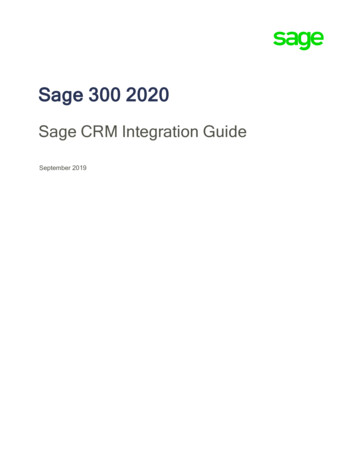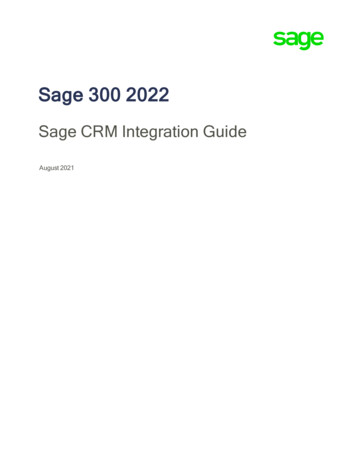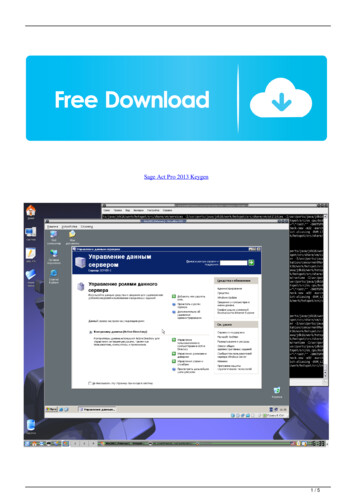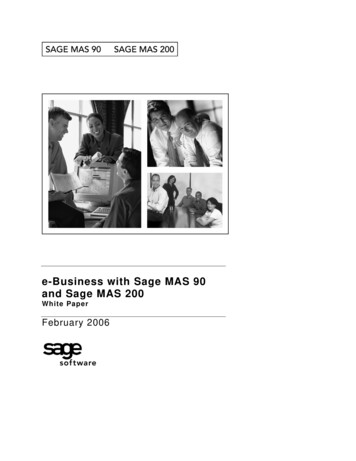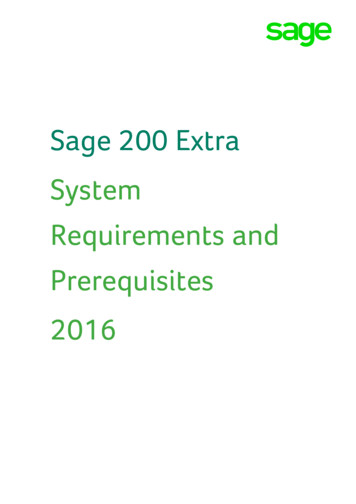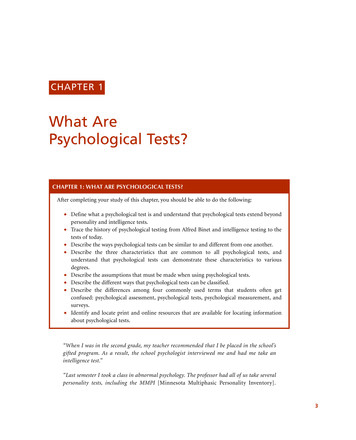
Transcription
CHAPTER 1What ArePsychological Tests?CHAPTER 1: WHAT ARE PSYCHOLOGICAL TESTS?After completing your study of this chapter, you should be able to do the following: Define what a psychological test is and understand that psychological tests extend beyondpersonality and intelligence tests. Trace the history of psychological testing from Alfred Binet and intelligence testing to thetests of today. Describe the ways psychological tests can be similar to and different from one another. Describe the three characteristics that are common to all psychological tests, andunderstand that psychological tests can demonstrate these characteristics to variousdegrees. Describe the assumptions that must be made when using psychological tests. Describe the different ways that psychological tests can be classified. Describe the differences among four commonly used terms that students often getconfused: psychological assessment, psychological tests, psychological measurement, andsurveys. Identify and locate print and online resources that are available for locating informationabout psychological tests.“When I was in the second grade, my teacher recommended that I be placed in the school’sgifted program. As a result, the school psychologist interviewed me and had me take anintelligence test.”“Last semester I took a class in abnormal psychology. The professor had all of us take severalpersonality tests, including the MMPI [Minnesota Multiphasic Personality Inventory].3
4——SECTION I: OVERVIEW OF PSYCHOLOGICAL TESTINGIt was awesome! We learned about different types of psychological disorders that the MMPIcan help diagnose.”“This year I applied for a summer job with a local bank. As a part of the selection process, I hadto participate in a structured interview and an assessment center.”“Yesterday I took my driving test—both the written and the road test. I couldn’t believe everything they made me do. I had to parallel park, switch lanes, and make both right and left turns.”If your instructor asked whether you have ever taken a psychological test, you would probably reportthe intelligence test you took as an elementary school student or the personality test you took in yourabnormal psychology class. If your instructor asked what the purpose of psychological testing is, youwould probably say its purpose is to determine whether someone is gifted or has a psychological disorder. Intelligence tests and personality tests are indeed psychological tests—and they are indeed used toidentify giftedness and diagnose psychological disorders. However, this is only a snapshot of what psychological testing is all about. There are many types of psychological tests, and they have many differentpurposes.In this chapter, we introduce you to the concept of psychological testing. We discuss what a psychological test is and introduce some tests you might never have considered to be psychological tests. Then,after exploring the history of psychological testing, we discuss the three defining characteristics of psychological tests and the assumptions that must be made when using these tests. We then turn our attention to the many ways of classifying tests. We also distinguish four concepts that students often getconfused: psychological assessment, psychological tests, psychological measurement, and surveys. Weconclude this chapter by sharing with you some of the resources (print and online) that are availablefor locating information about psychological testing and specific psychological tests.Why Should You Care About Psychological Testing?Before discussing what a psychological test is, we would like you to understand just how important itis for you to understand the foundations of psychological testing. Psychological testing is not justanother subject that you may study in college; rather, it is a topic that personally affects many individuals. Each day, psychological tests are administered by many different professionals to many different individuals, and the results of these tests are used in ways that significantly affect you and thosearound you. For example, test scores are used to diagnose mental disorders, to determine whethermedicines should be prescribed (and, if so, which ones), to treat mental and emotional illnesses, toselect individuals for jobs, to select individuals for undergraduate and professional schools (for example, medical school, law school), and to determine grades. Good tests facilitate high-quality decisions,and bad tests facilitate low-quality decisions.The consequences of bad decisions can be significant. For example, a poor hiring decision can dramatically affect both the person being hired and the hiring organization. From the organization’s perspective, a poor hiring decision can result in increased absenteeism, reduced morale of other staff, andlost productivity and revenue. From the employee’s perspective, a poor hiring decision may result in aloss of motivation, increased stress leading to depression and anxiety, and perhaps loss of opportunity to
Chapter 1: What Are Psychological Tests?——5make progress in his or her career. Although you might never administer, score, or interpret a test, it isvery likely that you or someone you know may have a life-altering decision made about him or her basedon test scores. Therefore, it is important that you understand the foundations of psychological testing,specifically how to tell whether a decision is a good or bad one. Being able to do this requires that youunderstand the foundations of psychological testing.What Are Psychological Tests?Each anecdote at the beginning of this chapter involves the use of a psychological test. Intelligence tests,personality tests, interest and vocational inventories, college entrance exams, classroom tests, structuredinterviews, assessment centers, and driving tests all are psychological tests. Even the self-scored tests thatyou find in magazines such as Glamour and Seventeen (tests that supposedly tell you how you feel aboutyour friends, stress, love, and more) can be considered psychological tests. Although some are more typical, all meet the definition of a psychological test. Together, they convey the very different purposes ofpsychological tests. For a continuum of some of the most and least commonly recognized types of psychological tests, see Figure 1.1.Similarities Among Psychological TestsPsychological testing is best defined as “the process of administering, scoring, and interpreting psychological tests” (Maloney & Ward, 1976, p. 9). But what exactly is a psychological test? We can easilyanswer this question by considering what all psychological tests do.First, all psychological tests require a person to perform some behavior—an observable and measurable action. For example, when students take a multiple-choice midterm exam, they must read thevarious answers for each item and identify the best one. When individuals take an intelligence test,they may be asked to define words or solve math problems. When participating in a structured jobinterview, individuals must respond to questions from the interviewer—questions such as “Tell meabout a time when you had to deal with an upset customer. What was the situation, what did you do,and what was the outcome?” In each of these cases, individuals are performing some observable andmeasurable behavior.Figure 1.1A Continuum of Psychological TestsMore TypicalLess TypicalPersonality testsVocational testsIntelligence testsInterest inventoriesAchievement testsAbility testsSelf-scored magazinetestsClassroom quizzes andexamsRoad portion of driving testStructured employmentinterviewsAssessment centers
6——SECTION I: OVERVIEW OF PSYCHOLOGICAL TESTINGSecond, the behavior an individual performs is used to measure some personal attribute, trait, orcharacteristic that is thought to be important in describing or understanding human behavior. Forexample, the questions on a multiple-choice exam might measure your knowledge of a particularsubject area such as psychological testing. The words you defined or the math problems you solvedmight measure your verbal ability or quantitative reasoning. It is also important to note that sometimes the behavior an individual performs is also used to make a prediction about some outcome. Forexample, the questions you answered during a structured job interview may be used to predict yoursuccess in a management position.So, what is a psychological test? It is something that requires you to perform a behavior to measuresome personal attribute, trait, or characteristic or to predict an outcome.Differences Among Psychological TestsAlthough all psychological tests require that you perform some behavior to measure personal attributes, traits, or characteristics or to predict outcomes, these tests can differ in various ways. For example,they can differ in terms of the behavior they require you to perform, what they measure, their content,how they are administered and formatted, how they are scored and interpreted, and their psychometricquality (psychometrics is the quantitative and technical aspect of mental measurement).Behavior PerformedThe behaviors a test taker must perform vary by test. For example, a popular intelligence test, theWechsler Adult Intelligence Scale–fourth edition (WAIS-IV), a general test of adult intelligence,requires test takers to (among other things) define words, repeat lists of digits, explain what is missingfrom pictures, and arrange blocks to duplicate geometric card designs. The Thematic Apperception Test(TAT), a widely used and researched projective personality test designed at Harvard University in the1930s, requires test takers to look at ambiguous pictures showing a variety of social and interpersonalsituations and to tell stories about each picture. The Graduate Record Examinations (GRE) GeneralTest, a graduate school admissions test that measures verbal and quantitative reasoning, critical thinking, and analytical writing skills, requires test takers to answer multiple-choice questions and respondto two analytical writing tasks. The road portion of an auto driving test typically requires test takers todo things such as start a car, change lanes, make right and left turns, use turn signals properly, and parallel park. Assessment centers require job applicants to participate in simulated job-related activities(that mimic the activities they would perform in the job) such as engaging in confrontational meetingswith disgruntled employees, processing e-mail and paperwork, and conducting manager briefings.Attribute Measured and Outcome PredictedWhat a test measures or predicts can vary. For example, the WAIS-IV asks individuals to explainwhat is missing from pictures to measure verbal intelligence. The TAT requires individuals to tell stories about pictures to identify conscious and unconscious drives, emotions, conflicts, and so on in orderto ultimately measure personality. The road portion of a driving test requires individuals to performvarious driving behaviors to measure driving ability. The GRE requires students to answer differenttypes of questions to predict success in graduate school.
Chapter 1: What Are Psychological Tests?——7Some of the characteristics, attributes, and traits commonly measured by psychological tests include personality, intelligence, motivation, mechanical ability, vocational preference, spatial ability, andanxiety. Some of the outcomes that tests typically predict includesuccess in college, worker productivity, and who will benefit fromspecialized services such as clinical treatment programs.More detail about the WAISIV can be found in TestSpotlight 1.1 in Appendix A.More detail about the GRE can befound in Test Spotlight 13.1 inAppendix A.ContentTwo tests that measure the same characteristic, attribute, or trait can require individuals to performsignificantly different behaviors or to answer significantly different questions. Sometimes how the testdevelopers define the particular characteristic, attribute, or trait affects how the test is structured. Forexample, the questions on two intelligence tests may differ because one author may define intelligenceas the ability to reason and another author may define it in terms of emotional intelligence—one’sability to understand one’s own feelings and the feelings of others and to manage one’s emotions(Gibbs, 1995).The difference in content may also be due to the theoretical orientation of the test. (We talk moreabout theoretical orientation and its relation to test content in Chapter 8.)Administration and FormatPsychological tests can differ in terms of how they are administered and their format. A test can beadministered in paper-and-pencil format (individually or in a group setting), on a computer, or verbally.Similarly, a psychological test may consist of multiple-choice items, agree/disagree items, true/false items,open-ended questions, or some mix of these. There are also tests that ask respondents to perform somebehavior such as sorting cards, playing a role, or writing an essay.Scoring and InterpretationPsychological tests can differ in terms of how they are scored and interpreted. Some tests are completed on scannable sheets and are computer scored. Some are hand-scored by the person administeringthe test. Others are scored by the test takers themselves. In terms of interpretation, some tests generateresults that can be interpreted easily by the test taker, and others require a knowledgeable professional toexplain the results to the test taker.Psychometric QualityLast, but extremely important, psychological tests can differ in terms of their psychometricquality. For now, let us just say that there are a lot of really good tests out there that measure whatthey say they measure and do so consistently, but there are also a lot of really poor tests out therethat do not measure what they say they measure. Good tests measure what they claim to measure,and any conclusions that are drawn from the test scores about the person taking the test are appropriate (they are what we call valid). Good tests also measure whatever they measure consistently(they are what we call reliable). The concepts of reliability and validity are central to determining
8——SECTION I: OVERVIEW OF PSYCHOLOGICAL TESTINGwhether a test is “good” or “bad” and are covered in detail later in this textbook. These concepts areso important that four chapters are devoted to them (Chapter 6 covers reliability, and Chapters 7–9 discuss validity).Because tests can differ in so many ways, to make informed decisions about tests, you must know howto properly critique a test. A critique of a test is an analysis of the test. A good critique answers many ofthe questions in Table 1.1. (These questions are also in Appendix B.) Your instructor may have additionalideas about what constitutes a good critique.INTERIM SUMMARY 1.1SIMILARITIES AND DIFFERENCES AMONG PSYCHOLOGICAL TESTSSimilaritiesDifferences All psychological tests require an individual to perform a behavior. The behavior performed is used to measuresome personal attribute, trait, or characteristic. This personal attribute, trait, or characteristic isthought to be important in describing or understanding behavior. The behavior performed may also be used to predict outcomes.Psychological tests can differ in terms of the following: The behavior they require the test taker toperform The attribute they measure Their content How they are administered and formatted How they are scored and interpreted Their psychometric qualityThe History of Psychological TestingSome scholars believe that the use of psychological tests can be traced to 2200 BCE in ancient China. Fora summary of this history, see For Your Information Box 1.1. Most scholars agree that serious researchefforts on the use and usefulness of psychological tests did not begin until the 20th century with theadvent of intelligence testing.Intelligence TestsAlfred Binet and the Binet–Simon ScaleLate in the 19th century, Alfred Binet founded the first experimental psychology research laboratory inFrance. In his lab, Binet attempted to develop experimental techniques to measure intelligence and reasoning ability. He believed that intelligence was a complex characteristic that could be determined by evaluating a person’s reasoning, judgment, and problem-solving abilities. Binet tried a variety of tasks tomeasure reasoning, judgment, and problem solving on his own children as well as on other children in theFrench school system.Binet was successful in measuring intelligence, and in 1905 he and Théodore Simon published thefirst test of mental ability, the Binet–Simon Scale. Parisian school officials used this scale to decidewhich children, no matter how hard they tried, were unable to profit from regular school programs(Binet & Simon, 1905).
Chapter 1: What Are Psychological Tests?——9Table 1.1Guidelines for Critiquing a Psychological TestGeneral descriptive informationWhat is the title of the test?Who is the author of the test?Who publishes the test, and when was it published? (Include dates of manuals, norms, and supplementary materials)How long does it take to administer the test?How much does it cost to purchase the test? (Include the cost of the test, answer sheets, manual, scoringservices, and so on) Is the test proprietary or nonproprietary? Purpose and nature of the testWhat does the test measure? (Include scales)What does the test predict?What behavior does the test require the test taker to perform?What population was the test designed for (for example, age, type of person)?What is the nature of the test (for example, maximal performance, behavior observation, self-report,standardized or nonstandardized, objective or subjective)? What is the format of the test (for example, paper-and-pencil or computer, multiple choice or true/false)? Practical evaluation Is the test manual comprehensive (does it include information on how the test was constructed, its reliabilityand validity, composition of norm groups, whether it is easy to read)? Is the test easy or difficult to administer? How clear are the administration directions? How clear are the scoring procedures? What qualifications and training does a test administrator need to have? Does the test have face validity?Technical evaluation Is there a norm group?Who comprises the norm group?What types of norms are there (for example, percentiles, standard scores)?How was the norm group selected?Are there subgroup norms (for example, by age, gender, region, occupation, and so on)?What is the estimate of the test’s reliability?How was reliability determined?What is the evidence for the validity of the test?How was the evidence for validity gathered?What is the standard error of measurement?What are the confidence intervals?Test reviews What do reviewers say are the strengths and weaknesses of the test? What studies that use the test as a measurement instrument have been published in peer-reviewed journals? How did the test perform when researchers or test users, other than the test developer or publisher, used it?Summary Overall, what do you see as being the strengths and weaknesses of the test?
10——SECTION I: OVERVIEW OF PSYCHOLOGICAL TESTINGFYIFOR YOUR INFORMATION BOX 1.1Psychological Tests: From Ancient China to the 20th Century2200BCE:Xia DynastySome scholars believe that the use of psychological tests dates back approximately 4,000 years to 2200when the Chinese emperor Yushun examined officials every third year to determine whether they weresuitable to continue in office (DuBois, 1970; Martin, 1870). However, modern scholars of ancient China saythat there is little archaeological evidence to support these claims. Reliable writing systems were developedby the Chinese somewhere between 1766 and 1122 BCE (Shangdynasty; Bowman, 1989). Nowhere in these writings were there anyhints suggesting that leaders were examined as just described. Even in1115 BCE, with the advent of more elaborate writing systems, therewere no inscriptions or writings to suggest the existence of such anexamination process (Martin, 1870).BCE,200–100BCE:Late Qin, Early Han DynastyMost modern scholars of ancient China agree that royal examinations began around 200 to 100 BCE, in the late Qin (Ch’in) or earlyHan dynasty (Eberhard, 1977; Franke, 1960; Pirazzoli-t’Serstevens, 1982; Rodzinski, 1979). Hucker (1978)believes that the first written examinations in world history began in 165 BCE, when the emperor administered written examinations to all nominees. Pirazzoli-t’Serstevens also believes that this was the beginningof all examination systems. Eberhard, on the other hand, admits that there may have been some assessment procedures before 165 BCE for selecting officials, who were probably tested more for literacy than forknowledge.618–907CE:T’ang DynastySuch examination systems seem to have been discontinued until the T’ang dynasty, when their use increasedsignificantly (Bowman, 1989).1368–1644: Ming DynastyDuring the Ming dynasty, the examinations became more formal. There were different levels of examinations(municipal, county, provincial, and national), and the results of examinations became associated with grantingformal titles, similar to today’s university degrees. On passing each level of examination, people received moretitles and increasingly more power in the civil service (Bowman, 1989). These examinations were distressful, andthis distress became a part of Chinese culture and also a part of folk stories and the literature (poems, comedies,and tragedies). Nonetheless, this examination system seemed to work well. Today, many scholars believe that thisexamination system kept talented men in the national government (Kracke, 1963) and kept members of thenational government from becoming nobility because of their descent.Seeing the value of these examinations for making important decisions, European governments, and eventually the governments of the United Kingdom, the United States, Canada, and other countries, adopted the use ofsuch examination systems.1791: France and BritainFrance initially began using this kind of examination system in 1791. However, soon after, Napoleon temporarily abolished them. The system adopted by France served as a model for a British system started in 1833 toselect trainees for the Indian civil service—the beginning of the British civil service.
Chapter 1: What Are Psychological Tests?——111860s: United StatesDue to the success of the British system, Senator Charles Sumner and Representative Thomas Jenckes proposedto Congress in 1860 that the United States use a similar system. Jenckes’s report, Civil Service in the United States,described the British and Chinese systems in detail. This report laid the foundation for the establishment of theCivil Service Act Health and Psychosocial Instruments (HAPI), passed in January 1883.20th Century: Western Europe and the United StatesIn 1879, Wilhelm Wundt introduced the first psychological laboratory, in Leipzig, Germany. At this time, psychology was the study of the similarities among people. For example, physiological psychologists studied howthe brain and the nervous system function, and experimental psychologists conducted research to discover howpeople learn and remember. Strongly influenced by James McKeen Cattell, an American researcher in Wundt’slaboratory, psychologists turned their attention to exploring individual differences. Cattell and others realized thatlearning about the differences among people was just as important as learning about the similarities among people. They believed that developing formal psychological tests to measure individual differences could help solvemany social problems, such as who should be placed in remedial programs, who should be sent to battlefields,and who should be hired for particular jobs. At this time, scientists were particularly interested in finding a quantitative way of measuring general intelligence.During the early 20th century, serious research efforts began on the use and usefulness of various testing procedures. Research conducted by scholars in the United States and Germany eventually led to Alfred Binet’sresearch on intelligence in children.Lewis Terman and the Stanford–BinetMore detail about theStanford-Binet IntelligenceBinet’s work influenced psychologists across the globe.Scales can be found in TestPsychological testing became a popular method of evaluation, andSpotlight 1.2 in Appendix A.the Binet–Simon Scale was adapted for use in many countries. In1916, Lewis Terman, an American psychologist, produced theStanford–Binet Intelligence Scales, an adaptation of Binet’s original test. This test, developed for use withAmericans ages 3 years to adulthood, was used for many years. A revised edition of the Stanford–Binetremains one of the most widely used intelligence tests today.The Wechsler–Bellevue Intelligence Scale and the Wechsler Adult Intelligence ScaleBy the 1930s, thousands of psychological tests were available, and psychologists and others weredebating the nature of intelligence (what intelligence was all about). This dispute over defining intelligence prompted the development in 1939 of the original Wechsler–Bellevue Intelligence Scale (WBIS)for adults, which provided an index of general mental ability (as did the Binet–Simon Scale) and revealedpatterns of a person’s intellectual strengths and weaknesses. DavidWechsler, the chief psychologist at Bellevue Hospital in New YorkMore detail about theCity, constructed the WBIS believing that intelligence is demonfourth edition of the WAIS-IVstrated based on an individual’s ability to act purposefully, think logcan be found in Testically, and interact/cope successfully with the environment (Hess,Spotlight 1.1 in Appendix A.2001; Rogers, 2001; Thorne & Henley, 2001). Wechsler published thesecond edition, the WBIS-II, in 1946.In 1955, Wechsler revised the WBIS-II and renamed it the Wechsler Adult Intelligence Scale (WAIS).In 1981 and 1991 the WAIS was updated and published as the WAIS-R and WAIS-III, respectively. In a
12——SECTION I: OVERVIEW OF PSYCHOLOGICAL TESTINGcontinuing effort to improve the measurement of intelligence, as well as the clinical utility and userfriendliness of the test, the fourth edition was published in 2008 (Pearson Education, 2009).Personality TestsIn addition to intelligence testing, the early 1900s brought about an interest in measuring personality.The Personal Data SheetDuring World War I, the U.S. military wanted a test to help detect soldiers who would not be able tohandle the stress associated with combat. To meet this need, the American Psychological Association(APA) commissioned an American psychologist, Robert Woodworth, to design such a test, which cameto be known as the Personal Data Sheet (PDS). The PDS was a paper-and-pencil psychiatric interviewthat required military recruits to respond yes or no to a series of 200 questions (eventually reduced to116 questions) that searched for mental disorders. The questions covered topics such as excessive anxiety, depression, abnormal fears, impulse problems, sleepwalking, nightmares, and memory problems(Segal & Coolidge, 2004). One question asked, “Are you troubled with the idea that people are watchingyou on the street?” (cited in Cohen, Swerdlik, & Phillips, 1996). During a pilot study of the test, newrecruits on average showed 10 positive psychoneurotic symptoms; recruits who were deemed unfit forservice generally showed 30 to 40 positive psychoneurotic symptoms (Segal & Coolidge, 2004).Unfortunately, because Woodworth did not complete the final design of this test until too late in the war,the PDS was never implemented or used to screen new recruits.After World War I, Woodworth developed the Woodworth Psychoneurotic Inventory, a version of thePDS. Unlike the PDS, the Woodworth Psychoneurotic Inventory was designed for use with civilians andwas the first self-report test. It was also the first widely used personality inventory.The Rorschach Inkblot Test and the TATDuring the 1930s, interest also grew in measuring personality by exploring the unconscious. With thisinterest came the development of two important projective tests: the Rorschach Inkblot Test and the TAT.The Rorschach, a projective personality test (described further in Chapters 2 and 14), was developed bySwiss psychiatrist Hermann Rorschach. The TAT, also a projective personality test, was developed by twoAmerican psychologists, Henry A. Murray and C. D. Morgan. Both tests are based on the personality theories of Carl Jung and continue to be widely used today for personality assessment.Vocational TestsDuring the 1940s, a need developed for vocational tests to help predict how successful an applicantwould be in specific occupations. The Public Employment Services needed such tests because thousandsof people had lost their jobs due to the Great Depression and thousands more were coming out of schooland seeking work. Because there were not enough jobs, people were forced to look for new lines of work.As a result, psychologists developed large-scale programs to design vocational aptitude tests that wouldpredict how successful a person would be at an occupation before entering it. In 1947, the Department
Chapter 1: What Are Psychological Tests?——13of Labor developed the General Aptitude Test Battery (GATB) to meet this need. The GATB was used fora variety of purposes, including vocational counseling and occupational selection.By the mid-20th century, numerous tests were available and they were used by many to makeimportant decisions about individuals. (We talk more about these decisions in Chapters 2 and 8.)Because of the increased use of psychological tests, to help protect the rights of the test taker, theAPA (1953) published Ethical Standards of Psychologists. (We discuss these ethical standards in moredetail in
Second, the behavior an individual performs is used to measure some personal attribute, trait, or characteristic that is thought to be important in describing or understanding human behavior. For example, the questions on a multiple -choice exam might measure your knowledge of a particular subject area such as psychological testing.
